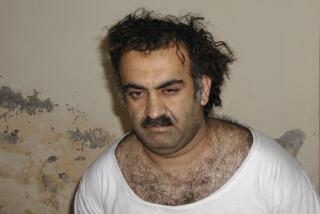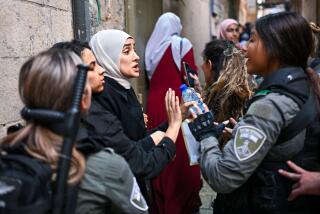Mosque Blast Suspects Arrested
- Share via
NAJAF, Iraq — Amid surging, grief-enraged crowds, police in this holy city arrested several suspects Saturday in the car-bomb attack that killed a leading Shiite cleric and about 100 other people.
Officials with the U.S.-led occupation authority said in Baghdad that at least four suspects were believed to have ties to the Al Qaeda terrorist network. The officials declined to offer details.
If true, the assertion would establish a critical link between the widely reported presence in Iraq of foreign subversives and a specific act of terrorism.
Friday’s mosque bombing during midday prayers was the third large-scale attack on a civilian, nominally pro-Western target in 22 days -- after those at the Jordanian Embassy and the United Nations headquarters in Baghdad -- and threatened to severely undermine U.S. efforts to stabilize postwar Iraq.
In Najaf, tens of thousands of people thronged the streets leading to the gold-domed Imam Ali Mosque, site of Friday’s devastating blast and one of Shiite Islam’s holiest shrines, where the mourners rhythmically beat their chests. Others held aloft the wooden coffins of dozens of victims, which were taken away for burial. Men sobbed openly.
According to Islamic tradition, the dead are to be buried quickly, but the funeral for Ayatollah Mohammed Bakr Hakim was delayed because of difficulty in recovering his remains.
Some of Hakim’s followers were convinced that he was still alive because it was so difficult to identify his remains.
His aides, however, said they found several of his rings and papers belonging to him amid the debris.
A funeral is scheduled to begin today, starting with a procession from Baghdad. He will be buried Tuesday in Najaf, about 85 miles south of the capital.
Hakim, 64, who returned from decades in exile just three months ago, was a relative moderate with a loyal following. He disliked the U.S.-led occupation of Iraq but was willing to cooperate with the coalition out of pragmatism.
Despite immediate fears that his slaying would unleash a bloody campaign of retaliation, most communities in Iraq remained relatively quiet.
There were large demonstrations in Baghdad and elsewhere, which vociferously blamed U.S. authorities for failing to restore law and order. They ended peacefully.
“The Americans will not protect us, yet they do not allow us to protect ourselves as we are capable of,” said Sheik Jabbar Ajeel Khuzaie as he sipped tea in a hotel lobby in Najaf with other tribal leaders.
“This situation only seems to be getting worse. If the Americans cannot provide us with security, we must do it ourselves.”
Political and religious leaders issued pleas for calm and urged citizens of all faiths to resist the bombers’ attempts to turn Iraqis against one another.
“We call upon the Iraqi people to be unified and integrated, so as to stand in the face of sedition, sectarianism and racism,” said the Islamic Dawa Party, a conservative Shiite group.
There was confusion Saturday night over the arrests. Reports put the figure anywhere from three to nearly 20.
In the highly charged atmosphere after the blast, any and all outsiders were viewed with hostility. Journalists were repeatedly attacked and threatened.
Some of the detained may simply have been unwelcome, with no connection at all to the bombing, said Maj. Rick Hall of the Marines, who is assisting the Iraqi police in the investigation.
Charles Heatly, a spokesman for the occupation authority in Baghdad, confirmed the detention of four men portrayed as having connections to Al Qaeda.
News agencies quoted Najaf officials as saying that the team consisted of two Saudi nationals and two former Iraqi paramilitary fighters who confessed to the bombing and revealed plans for additional assassinations, sabotage and other violence.
Arabic television showed pictures of two men being taken into custody and ushered into waiting police vehicles. One slightly balding man had a short beard and wore Western clothing; the second was dressed in a white robe and kaffiyeh typical of Persian Gulf Arabs.
Heatly would not offer details about the suspects’ detention or the investigation.
“It’s a little early to comment,” he said. “We don’t feel we have the full details yet.”
The bomb that claimed so many lives was packed in either a BMW or a Toyota Land Cruiser that had been parked overnight outside the southern portico of the mosque, Hall said.
That vantage point gave anyone in the vehicle a view of the exit most often used by Hakim, who led Friday prayers minutes before he was killed.
A police officer reported seeing the vehicle parked at that location but apparently did not investigate.
The fact that the vehicle was left overnight led investigators to conclude that the bombing was not a suicide mission but instead done by remote control.
“If you’re going to stage a vehicle in an advantageous setup, why would a guy detonate it from inside if he could do it from a distance?” Hall said.
The plot involved precise planning and an enormous payload, which broke many of the shrine’s blue mosaic tiles and demolished a row of shops across the street. It was not yet clear what kind of explosive material was used. Whoever did it might have staked out Hakim from a nearby hotel, Hall said.
No organization has claimed responsibility for the bombing. There have been violent rivalries within the Shiite community, whose members make up the majority in Iraq.
Most Iraqis blamed former officers and agents from the regime of deposed President Saddam Hussein, who are thought to be eager to sow discontent and make the new Iraq ungovernable for the Americans and their supporters.
Just about everybody also held U.S. forces responsible for failing to protect Hakim.
Signs of political blowback already were appearing. Seyyid Mohammed Bahr Uloom, a member of the U.S.-appointed Iraqi Governing Council from Najaf, announced that he was suspending his membership in protest. News reports quoted him as urging that the occupation authority turn security matters back to Iraqis so they could protect their religious shrines.
The U.S.-led occupation administration “roundly rejects” the accusation that it has failed to provide security, Heatly said.
U.S. officials have blamed both Hussein loyalists and Muslim extremist groups associated with Al Qaeda for the increasing number of attacks in Iraq on U.S. and allied troops, and on civilian targets.
Al Qaeda members are Sunni Muslims, like the minority faction that had ruled Iraq. Many Sunnis are now among the most resentful toward the U.S. invasion. Al Qaeda’s views have been heavily influenced by Wahhabism, a puritanical form of the religion that has frequently been at odds with Shiite Islam.
In Iraq, Wahhabis live primarily in the same Hussein stronghold north and west of Baghdad that has been the site of most of the deadly ambushes on U.S. troops. In interviews with The Times in recent weeks, Iraqis familiar with the anti-U.S. resistance noted a growing alliance between Wahhabis and former Hussein loyalists.
Rumors that Wahhabis were responsible for the bombing swept through the teeming streets of Najaf throughout the day.
Hall, the Marine major, said two of the people in custody had been turned over to the Marines by angry residents who accosted them at a restaurant.
Both were from the southern city of Basra, and their beards and way of speaking made people suspect that they were Wahhabis, he said.
“It almost seemed like these guys were in the wrong place at the wrong time,” Hall said, although he added there were “inconsistencies” in their stories. A third man was arrested at an Internet cafe here, the cafe owner said.
A new force of 400 Iraqi police is scheduled to begin patrolling the area around the shrine as early as Tuesday, Hall said, while Marines will patrol an outer perimeter. He said the Marines had offered to make such patrols earlier but had been turned down by Najaf’s religious leadership, sensitive to a U.S. military presence so close to the revered site.
“They did not want us in that area,” Hall said. “They didn’t have too much trust in us.”
There was also confusion over the rising death toll, with hospitals on Saturday reporting 125 dead before starting to scale back the numbers because of double-counting of bodies.
At the Najaf Teaching Hospital, which contains the city’s only morgue, the many cadavers and body parts overwhelmed the facility’s capacity. Corpses were left piled on the floor overnight.
The Ministry of Health on Saturday provided a refrigerated truck that can hold 200 bodies, easing the burden, said Dr. Safaa Amredi, the hospital director.
The bombing “was done by people who don’t want us to live peaceful, stable lives in our country,” said Majid Mohammed Jawad, a 40-year-old cigarette salesman who spoke from his hospital bed. Bandages covered his right ear and knee, which had been cut by shrapnel.
He said he survived only because the force of the blast sent him flying under a metal garbage container, which absorbed most of the shrapnel when the bomb exploded.
“I am alive because of that garbage can,” Jawad said.
Like others, Amredi said he feared spiraling violence among Shiites.
On Saturday evening, he said, he was informed that someone opened fire at the home of Muqtader Sadr, a young cleric whose group is a rival to the slain religious leader. Sadr, the son of a revered cleric assassinated by the Hussein regime, is stridently opposed to the U.S.-led occupation and has a strong following among Shiites in Baghdad.
The report of the attack could not be independently confirmed.
There were no injuries in the shooting, Amredi said, but he voiced fears that it could signal the onset of factional attacks among Shiite groups.
“We do not need more killing now,” he said.
*
Times staff writers Tracy Wilkinson and Carol J. Williams in Baghdad contributed to this report.
--- UNPUBLISHED NOTE ---
In stories after April 9, 2004, Shiite cleric Muqtader Sadr is correctly referred to as Muqtada Sadr.
--- END NOTE ---
More to Read
Sign up for Essential California
The most important California stories and recommendations in your inbox every morning.
You may occasionally receive promotional content from the Los Angeles Times.










